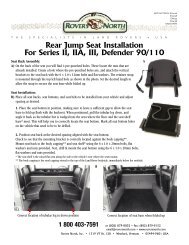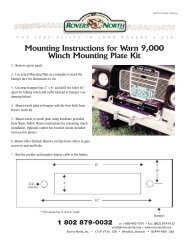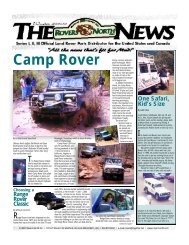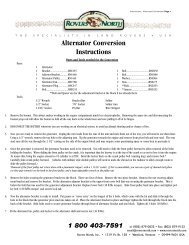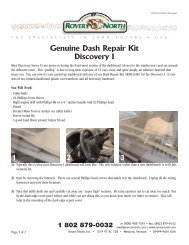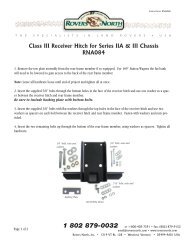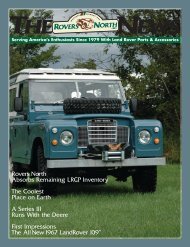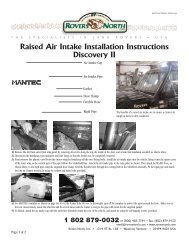Create successful ePaper yourself
Turn your PDF publications into a flip-book with our unique Google optimized e-Paper software.
REDUCE - RE-USE - RE-FLAP<br />
Living in Vermont, we experience one of the most corrosive<br />
environments in the country. Harsh winters mean tons of road salt<br />
and with more dirt roads than paved roads, our Land Rovers receive<br />
a good abrasive blast of gravel to enhance the salt’s penetration. It is<br />
documented that salt will increase the rate of corrosion by a factor of<br />
900 times the normal rate. Unfortunately, it does not end with winter.<br />
To combat the loss of road surface from dust, estimated at over 2.5<br />
inches on average per year, towns liberally apply highly corrosive<br />
liquid chloride to their dirt roads to ensure you will continue rusting<br />
right on through the summer.<br />
In this never-ending fight against corrosion, front mud flaps play<br />
a key role protecting the underbody and chassis of our Land Rovers.<br />
Because they literally take a beating and are often saddled with<br />
built-up ice and snow, their life span is generally limited to about 3<br />
years before they begin to crack along their flex line. Unlike most<br />
failed parts, a broken mud flap can be assigned a new, and vital role<br />
in the underside protection of your Land Rover.<br />
_______<br />
________<br />
Torn front mud flap is replaced with a new one, and is cut square below<br />
its metal bracket.<br />
Planned Obsolescence? Defender inner wheel well is galvanized steel and<br />
offers a high level of corrosion protection except for the area left open in<br />
front of the toe box. This was not always the case. Early Land Rover 90<br />
and 110 wheel wells were built to protect the steel toe box and doorpost<br />
area from debris and corrosion. Only Land Rover can explain why it was<br />
cut out on later Defenders to expose this vulnerable area.<br />
Place the trimmed old mud flap in front of the toe box. Notice how it<br />
nicely fits into this space with its edge fitting into the stepped edge of the<br />
flexible eyebrow. Mark on the mud flap the location of the 2 self-tapping<br />
screws that secure the inner wheel well near the top of the cut out area.<br />
An easy way to do this is to dab paint, or white out on to the screw heads<br />
and press the mud flap into position. Then with a hole punch or drill, put<br />
2 holes into the mud flap were it is marked by the paint.<br />
Screw the mud flap into place. Ideally, the factory self-tapping screws and<br />
washers are replaced with stainless steel screws and large stainless<br />
fender washers, as shown.<br />
51



